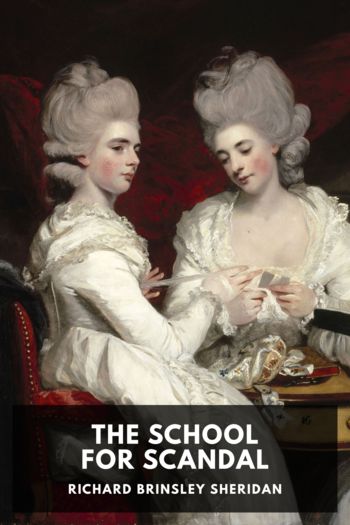The School for Scandal - Richard Brinsley Sheridan (reading strategies book txt) 📗

- Author: Richard Brinsley Sheridan
Book online «The School for Scandal - Richard Brinsley Sheridan (reading strategies book txt) 📗». Author Richard Brinsley Sheridan
It was in America also that two of the most noteworthy incidents in the career of the School for Scandal occurred. One took place during a visit to this country of Macready, who, early accustomed to enact the heavy villains of the stage, took a fancy to the part of Joseph, and, not finding it as prominent as he liked, sought to rectify this defect by boldly cutting down the other characters; and thus with the excision of the scandal-scene, the picturescene, and several other scenes, the School for Scandal, reduced to three acts, was played as an afterpiece, with Macready, very imperfect in the words of the part, as Joseph, dressed in the black coat and trousers of the nineteenth century. It may be remembered that Macready’s greater predecessor as the chief of English tragedians, John Philip Kemble, was also wont to act in the School for Scandal; but he chose to appear as the more jovial and younger of the Surfaces, and his performance of the careless hero was known as “Charles’s Martyrdom.”
The second noteworthy incident was the performance of the School for Scandal, on the centenary of its first production, on May 8, 1877, at the Grand Opera House, Toronto, in the presence of the Governor General of Canada, Lord Dufferin, the greatgrandson of the author.
In the same year that this memorable performance took place in a former French province, Miss Genevieve Ward, an American actress, appeared as Lady Teazle in Paris in a French version; and the foremost of Parisian dramatic critics, Francisque Sarcey seized the opportunity for a most interesting appreciation of the play. He considered it one of the best of the second class, and, as in his view the first class would contain few plays but those of Shakespeare and Molière, this is high praise. He ranked the School for Scandal with the Mariage de Figaro, and instituted the comparison of Sheridan with Beaumarchais, which Taine had already attempted. But Sarcey held a more just as well as a more favourable opinion of the School for Scandal than Taine. An earlier French critic, Villemain, who edited a close translation of the play for the series of foreign masterpieces, declared it to be one of the most amusing and most wittily-comic plays which can anywhere be seen, and he hit upon one of its undoubted merits when he pointed out that its “wit is so radically comic that it can be translated, which, as all know, is the most perilous trial for wit possible.” Sarcey informed us that the School for Scandal is now and has been for years, used as a textbook in French schools, and that he himself was taught to read English out of Sheridan’s play. Such was also the opinion of M. Hégésippe Cler, who published a French translation of the School for Scandal in





Comments (0)